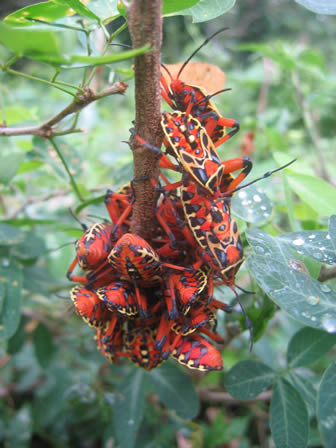Insects

All insects belong to the class Insecta, the largest class within the phylum Arthropoda. The name Insecta is derived from the Latin word insectuon which can be roughly translated to “an animal with a notched or divided body”. The word insectare in Latin mean to cut into, to cut up. The science of studying insects is called entomology.
Insects can be found almost everywhere and in almost every habitat on earth. There are even insects living in the oceans although only a small number can be found there. Most insects are short lived in their adult form.
A common mistake is to call spiders insects. Spiders are not insects and there are many differences between insects and spiders.
Insects have three pairs of legs, two antennae, a three parted body and hard exoskeletons. On the head they got large compounded eyes, the antennae and the mouth. The wings and legs are attached to the thorax. The abdomen usually consists of 11 segments. There is great variation in appearance between different insects.
Insects constitute the most diverse type of animal group on the planet and more than half of all described animal species on the planet are insects. There is no exact number on how many different species of insects there are and estimations vary greatly. Some think there are as few as 2 million species while others suggest as many as 50 million species. Recent, and at the moment more highly regarded, estimations suggest 6-10 million species. This means that insects might make up as much as 90% of all species on earth. New species of insect constantly develop; a new mosquito species has for instance developed in the London underground and new butterfly species have developed where different populations meet.
A very large number of insects have been described today although they likely only make up a fraction of all the species that are out there. Among the described species are approximately 2,200 species of praying mantis, 5,000 dragonfly, 20,000 grasshopper, 82,000 true bug, 120,000 fly, 170,000 butterfly and moth, and 360,000 beetle species. The widest diversity of insect is found near the equator and the diversity then declines the further north or south one travels.
Most insects lay eggs some species give birth to live young. Some of these species are ovoviviparous while others are viviparous. All insects moult as they grow. Some insects protect their eggs and young, while other shows no parental care. Some species even protect the young until they reach adulthood.
The smallest known insect is the fairy fly (Dicopomorpha echmepterygis). This species only grow to be 0.139 mm (0.00547 in) long. The largest insect in the world is a debated question as it depends on whether you look at length or weight. The longest insects in the world are Phobaeticusinsects,a chain a type of stick insects that grow to be56.7 cm / 22.3 inches long. The heaviest documented insect was a Goliath weta weighing 70 g (2½ oz) but some claim large beetles like Goliathus goliatus, Goliathus regius and certain Cerambycid beetles such as Titanus giganteus to grow bigger than that. There is however no known confirmed case of this. The largest insect of all time was a large dragonfly but this insect is now extinct.
Insects have a bad reputation and people often focus on their bad qualities, calling them pests and overlooking all the good things insects do for us humans by pollinating plants etc.
